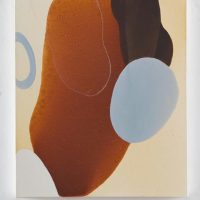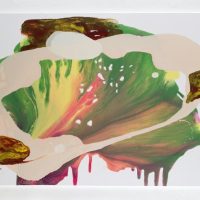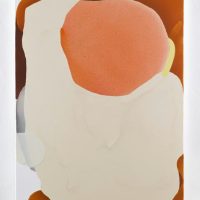Somody’s works, perhaps unintentionally, have a powerful and evocative poetic force, just like the title of Kooning’s work. If the artist didn’t mind, I would say that the result of his work often has a poetic beauty, a primary beauty, that is created through a technique barely used these days – it was the revolutionary innovation of American painting in the 50s, namely, Jackson Pollock. During the creative process, the patches of colour stay on the surface as the traces of self-determining material, usually without using brushes.
The method of dripping, pouring, spilling and dropping, known in Europe as Tachisme, displayed the above mentioned aesthetic appearance primarily on our continent. In America, it was supposed to convey freedom and wild force, according to the artists’ efforts, by use of large-sized works and powerful, characteristic colours.
Péter Somody’s artistic intentions relate to these two artists, who have been committed to the imagery defined by colour and form since the beginning of their career, and can still remain timely. Somody’s works are connected coherently, yet, they are renewed from time to time. Two years ago we could see different series: large-sized oil-paintings and fibreglass pictures that he had started ten years ago, and continue to these days.
In the present exhibition, we will also introduce illuminating boxes as their developed variants, and the oil-paintings that were recently presented in the Museum of Győr – these ones outline spontaneous, playful shapes with refreshed colours and skilled technical expertise compared to the previous series.
The real surprise of the exhibition, apart from the illuminating boxes and fibreglass pictures, are the small-sized, unique graphics created seven years ago, that show the same free paint use and playfulness than the latest illuminating boxes; the artist encounters the infinite beauty of the patches of colours, and puts aesthetically disturbing details in them. Even the colours are disharmonious, bright red patches counterpoint blinding pinks, whose smooth surface is broken by misty-grey dissolving here and there. The previously velvety colour-accords are disrupted – intentionally – by contrasts and peculiar letters and illustrations.
Brigitta Muladi



